His Universe within
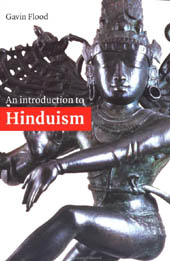
"The Upanishads represent the culmination of a process which comes to regard the individual self as having great inner depths, and, indeed, as containing the universe within. The truth (satya) is the absolute (brahman) which is also the self (atman).” (Gavin D. Flood, 1996, 85)
"The Gospel of Thomas also suggests that Jesus is aware of, and criticizing the views of the Kingdom of God as a time or a place that appear in the other gospels. Here Jesus says," If those who lead you say to you," look, the Kingdom is in the sky," then the birds will get there first. If they say"It's in the ocean," then the fish will get there first. But the Kingdom of God is within you and outside of you. Once you come to know yourselves, you will become known. And you will know that it is you who are the children of the living father.” (Elaine H. Pagels, PBS and WGBH/FRONTLINE, 1998)
Since November 1993 the transcendental experiences of children's souls, each meeting the Divine Mother hundreds of times in the Kingdom of God within* over the years, have been recorded. They have identified Shri Mataji Nirmala Devi to be Her incarnation, sent to deliver the message and means to participate in the promised Resurrection and evolution into the eternal spirit.
Kingdom of God within*
"At the same time, the knowledge Jesus communicates in the gnostic gospels and related texts is a knowledge both of what is outside and of what is inside...
In the Gospel of Thomas Jesus says that the kingdom is inside and outside (3:3), and the inner may be like the outer and the outer like the inner (22:4)...
Another Valentinian gospel, the Gospel of Philip, gives a meditation on the outer and the inner. Based on an utterance of Jesus very much like Gospel of Thomas 22:4, this meditation maintains it is actually more fitting to focus attention upon what is within, what is innermost. The world of the pleroma, the fullness of God, thought by many to be the divine realm above, truly is within. In the words of the Gospel of Philip, 'What is innermost is the fullness, and there is nothing further within' (68). If the fullness is within, so, in the Gospel of Thomas, is the kingdom within, or spread out upon the earth, unseen by people (3:3; 113:4), and so also, in the Gospel of Mary, is the child of humankind (or son of man) within. As Jesus says to the disciples in the Gospel of Mary, 'Follow that. Those who seek will find it'(8).” (Marvin Meyer, 2009, p. xxiii-xxiv)
“But those who have got Realization will enter into the Kingdom of God. You have to enter into the Kingdom of God here, as I say, in the Seventh Chakra.
The Paraclete Sri Mataji
The New Age Has Started, Houston, USA—October 6, 1981
Visions Of The Universe: Kazuaki Iwasaki
On August 20, 1995, at the home of Sahaja Yogi, Dattatreya, in Maine, USA, Kash was shown the book Visions of the Universe containing vivid and strikingly realistic paintings of the planets in the universe by Japanese master painter, Kazuaki Iwasaki. (The text is by Isaac Asimov and preface by Carl Sagan.) He was told to look at each page and point out the celestial bodies he had seen in his mystic journeys as he traveled across the universe with Shri Mataji, and reminded to be sure that they matched.
He identified the following planets as he traveled with Shri Visva-Dharini Devi in the universe within the Sahasrara within himself:
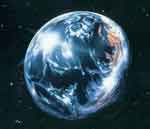
The Earth looks as that on page 17. He is sure as he had seen it from outer space while descending upon it with the Great Adi Shakti on 1994-04-30.
Earth is the third planet in distance outward from the Sun. It is the only planetary body in the solar system that has conditions suitable for life, at least as known to modern science. Gravitational forces have molded the earth, like all celestial bodies, into a spherical shape. However, the earth is not an exact sphere, being slightly flattened at the poles and bulging at the equator. The earth is surrounded by an envelope of gases called the atmosphere, of which the greater part is nitrogen and oxygen. (Columbia Electronic Encyclopedia)
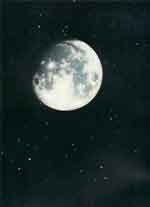
The moon was similar to that on page 19
The moon is the earth's nearest neighbor in space. In addition to its proximity, the moon is also exceptional in that it is quite massive compared to the earth itself, the ratio of their masses being far larger than the similar ratios of other natural satellites to the planets they orbit with the exception of Charon and Pluto. (Columbia Electronic Encyclopedia)
but not as in page 22 (below); he has seen the moon from a distance as that depicted on page 19 above. Page 22 shows the surface of the moon from close-up, but he never came that close to it.The moon is Earth's only natural satellite. The moon is a cold, dry orb whose surface is studded with craters and strewn with rocks and dust (called regolith). The moon has no atmosphere. Recent lunar missions indicate that there might be some frozen ice at the poles.
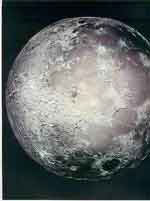
The same side of the moon always faces the Earth. The far side of the moon was first observed by humans in 1959 when the unmanned Soviet Luna 3 mission orbited the moon and photographed it. Neil Armstrong and Buzz Aldrin (on NASA's Apollo 11 mission, which also included Michael Collins) were the first people to walk on the moon, on July 20, 1969.
The Moon, of course, has been known since prehistoric times. It is the second brightest object in the sky after the Sun. As the Moon orbits around the Earth once per month, the angle between the Earth, the Moon and the Sun changes; we see this as the cycle of the Moon's phases. The time between successive new moons is 29.5 days (709 hours), slightly different from the Moon's orbital period (measured against the stars) since the Earth moves a significant distance in its orbit around the Sun in that time.
Mars looked identical to that of pages 25.
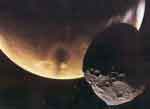
Mars has a striking red appearance, and in its most favorable position for viewing, when it is opposite the sun, it is twice as bright as Sirius, the brightest star. Mars has a diameter of 4,200 mi (6,800 km), just over half the diameter of the earth, and its mass is only 11% of the earth's mass. The planet has a very thin atmosphere consisting mainly of carbon dioxide, with some nitrogen and argon. Mars has an extreme day-to-night temperature range, resulting from its thin atmosphere, from about 80F (27C) at noon to about -100F (-73C) at midnight; however, the high daytime temperatures are confined to less than 3 ft (1 m) above the surface. (Columbia Electronic Encyclopedia)

Jupiter is similar as depicted on page 27.
Jupiter is the fourth brightest object in the sky (after the Sun, the Moon and Venus; at some times Mars is also brighter). It has been known since prehistoric times. Galileo's discovery, in 1610, of Jupiter's four large moons known as the Galilean moons was the first discovery of a center of motion not apparently centered on the Earth. It was a major point in favor of Copernicus's heliocentric theory of the motions of the planets; Galileo's outspoken support of the Copernican theory got him in trouble with the Inquisition.

The asteroids were similar as those on page 34. However, they are of various shapes and size. (Painting is that of Saturn with an outer ring made up of bits of particles.)
On the first day of January 1801, Giuseppe discovered an object which he first thought was a new comet. But after its orbit was better determined it was clear that it was not a comet but more like a small planet. Piazzi named it Ceres, after the Sicilian goddess of grain. Three other small bodies were discovered in the next few years (Pallas, Vesta, and Juno). By the end of the 19th century there were several hundred.
Several hundred thousand asteroids have been discovered and given provisional designations so far. Thousands more are discovered each year. There are undoubtedly hundreds of thousands more that are too small to be seen from the Earth. There are 26 known asteroids larger than 200 km in diameter. Our census of the largest ones is now fairly complete: we probably know 99% of the asteroids larger than 100 km in diameter. Of those in the 10 to 100 km range we have cataloged about half. But we know very few of the smaller ones; perhaps as many as a million 1 km sized asteroids may exist.
Asteroid, planetoid, or minor planet, small body orbiting the sun. More than 10,000 asteroids have orbits sufficiently well known to have been cataloged and named; thousands more exist. Most asteroids are irregularly shaped, unlike the spherically shaped major planets. The largest asteroid, Ceres, has a diameter of c.630 mi (1000 km); the three next largest are Pallas, Vesta, and Juno. Only Vesta can be seen with the naked eye. Many asteroids are no larger than a few kilometers; in 1991, an asteroid only 33 ft (10 m) in diameter was found. Many asteroids are so small that their sizes cannot be measured directly; in many cases, their sizes have been estimated from their brightness and distances. (Columbia Electronic Encyclopedia)

Pluto was exactly as shown on page 38. The reason he is so sure is the lack of detail when one passes Pluto on the night-side, with only a thin crescent illuminated by the very distant sun.
Pluto, in astronomy, the 9th and most distant known planet from the sun, with an elliptical orbit usually lying beyond that of Neptune. Pluto's mean distance from the sun is 3.67 billion mi (5.91 billion km), and its period of revolution is about 248 years. Since Pluto has the most elliptical and tilted orbit of any planet (eccentricity .250, inclination 17), at its closest point to the sun it passes inside the orbit of Neptune; between 1979 and 1999 it was closer to the sun than Neptune was. It will remain farther from the sun for 220 years, when it will again pass inside Neptune's orbit. Its surface consists largely of frozen nitrogen. It is thought to have a rocky, silicate core; its thin atmosphere probably contains nitrogen, carbon monoxide, and methane. Its surface temperature is estimated to be about -360F (-218C), a temperature at which most gases exist in the frozen state. (Columbia Electronic Encyclopedia)
Pluto's composition is unknown, but its density (about 2 gm/cm3) indicates that it is probably a mixture of 70% rock and 30% water ice much like Triton. The bright areas of the surface seem to be covered with ices of nitrogen with smaller amounts of (solid) methane, ethane and carbon monoxide. The composition of the darker areas of Pluto's surface is unknown but may be due to primordial organic material or photochemical reactions driven by cosmic rays.
Little is known about Pluto's atmosphere, but it probably consists primarily of nitrogen with some carbon monoxide and methane. It is extremely tenuous, the surface pressure being only a few microbars. Pluto's atmosphere may exist as a gas only when Pluto is near its perihelion; for the majority of Pluto's long year, the atmospheric gases are frozen into ice. Near perihelion, it is likely that some of the atmosphere escapes to space perhaps even interacting with Charon. The Pluto Express mission planners want to arrive at Pluto while the atmosphere is unfrozen.
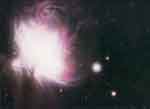
The Orion Nebula matched that of page 39.
Orion the Hunter is perhaps the best known constellation in the sky, well placed in the evening at this time of the year for observers in both the northern and southern hemispheres, and instantly recognisable. And for astronomers, Orion is surely one of the most important constellations, as it contains one of the nearest and most active stellar nurseries in the Milky Way, the galaxy in which we live.
Here tens of thousands of new stars have formed within the past ten million years or so - a very short span of time in astronomical terms. For comparison: our own Sun is now 4,600 million years old and has not yet reached half-age. Reduced to a human time-scale, star formation in Orion would have been going on for just one month as compared to the Sun's 40 years.
Just below Orion's belt, the hilt of his sword holds a great jewel in the sky, the beautiful Orion Nebula. Bright enough to be seen with the naked eye, a small telescope or even binoculars show the nebula to be a few tens of light-years' wide complex of gas and dust, illuminated by several massive and hot stars at its core, the famous Trapezium star. It is located near the middle of the"sword hanging from Orion's"belt of stars. Its central bright region is about 1 in diameter and it has a total extension of 3. It is about 1,000 light-years distant and as many as 60 light-years in diameter. The nebula is an enormous cloud of gas surrounding a cluster of very hot young stars. To the naked eye the nebula appears to be a faint star but becomes a vague patch of light when viewed through binoculars. The bright region is divided into two sections, the northeast portion being cataloged separately as M43 or NGC 1982. The Orion Nebula is the nearest major site to earth of massive star formation.
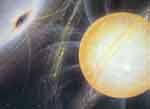
The Black Hole was like that of page 43. Kash is very sure as the Great Cosmic Mother took him through it on his first visit to Shri Ganesha.
Black hole, in astronomy, celestial object of such extremely intense gravity that it attracts everything near it and in some instances prevents everything, including light, from escaping. The term was first used in reference to a star in the last phases of gravitational collapse by the American physicist John A. Wheeler.
Gravitational collapse begins when a star has depleted its steady sources of nuclear energy and can no longer produce the expansive force, a result of normal gas pressure, that supports the star against the compressive force of its own gravitation. As the star shrinks in size (and increases in density), it may assume one of several forms depending upon its mass... .
Because light and other forms of energy and matter are permanently trapped inside a black hole, it can never be observed directly. However, a black hole could be detected by the effect of its gravitational field on nearby objects (e.g., if it is orbited by a visible star), during the collapse while it was forming, or by the X rays and radio frequency signals emitted by rapidly swirling matter being pulled into the black hole. A small number of possible black holes have been detected, although none of the discoveries has been conclusive. (Columbia Electronic Encyclopadia)
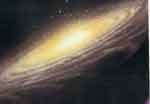
The galaxy was alike that of page 45, but there are countless others in the universe.
The Milky Way is the galaxy which is the home of our Solar System together with at least 200 billion other stars and their planets, and thousands of clusters and nebulae including at least almost all objects of Messier's catalog which are not galaxies on their own. All the objects in the Milky Way Galaxy orbit their common center of mass, called the Galactic Center.
As a galaxy, the Milky Way is actually a giant, as its mass is probably between 750 billion and one trillion solar masses, and its diameter is about 100,000 light years. Radio astronomial investigations of the distribution of hydrogen clouds have revealed that the Milky Way is a spiral galaxy of Hubble type Sb or Sc. Therefore, out galaxy has both a pronounced disk component exhibiting a spiral structure, and a prominent nuclear reagion which is part of a notable bulge/halo component.
Kash has also seen Venus, Mercury and the Sun but they are not similar to that in Visions of the Universe, which depict the surface area of these planets. But they do look familiar as he often saw them from a distance as he traveled across the Universe with the Great Adi Shakti Shri Mataji Nirmala Devi to visit the Divine Messengers.
If Kash were to ever defend himself against scientific skeptics and disbelieving humans the words of Jodie Foster in the film Contact would be most appropriate:
“I had an experience. I can't prove that. I can't just explain it but everything that I know as a human being, everything that I am, tells me that it was real. I was given something wonderful, something that changed me forever, a vision of the universe that tells us undeniably how tiny and insignificant and how rare and precious we all are, a vision that tells us that we belong to something that is greater than ourselves, that we are not, that we are not alone.
I wish I could share that. I wish that everyone, even for one moment, could feel that awe and humility and the hope.”
Jodie Foster, Contact (1997)

“There is nothing to look outside. Everything is inside.”
Shri Pratyag-Rupa Devi
Pratyag-Rupa [781st]: Looking inside away from sense and sense organs: Introversion or 'Antarmukhatva'.
“First of all you should absolutely fix yourself on the Truth and the Truth is that you are the instrument of God, that you have got Realization, that you have got a special awareness which people do not have. Stand on that and proclaim it. You are standing on the Truth and that is such a power, such a strength...
So prepare yourself to move to any place because you have to take this compassion everywhere, and you have to prosper that Kingdom of God. You have to serve Him and this service is only possible if you know that you are here for a very great universal task not only for U.K., for India, or for America, but you are here for a global task which is the epitome of our evolution. This is the highest thing we have to do for our creation and for our Creator, and you are chosen for that.”
Shri Visva-Dharini Devi
Dedication And Devotion, London, U.K. — August 6, 1982
Visva-Dharini [759th]: Who contain all the universes.
Jayaram V, www.hinduwebsite.com

"This impersonalist monosim is central to the earlier Upanishads and becomes a theology of great importance, particularly in the later Vedanta tradition and in modern Neo-Hinduism. The essence of the self is the absolute, realized within the self, through the knowledge of the ritual's inner meaning and the withdrawal of the senses from the sensory world. The emphasis in the Upanishads is on the internalization of ritual and the texts are even critical of their external performance. The true meaning of the ritual is not to be found in outer action, but in the realization of its symbolism and its esoteric meaning revealed by the Upanishads.
The Upanishads represent the culmination of a process which comes to regard the individual self as having great inner depths, and, indeed, as containing the universe within. The truth (satya) is the absolute (brahman) which is also the self (atman). This is the single reality underlying the diversity of appearances, knowledge of which is the purpose of the ritual's internalization. This knowledge is not simply information to be understood, but a direct and immediate intuition experienced as joy or bliss. To quote the Taittirya Upanishad: 'He knew that brahman is bliss (ananda). For truly, beings here are born from bliss, when born, they live by bliss and into bliss, when departing, they enter'. This is no ordinary bliss, but is at the top of the hierarchy of blissful experiences, far beyond any ordinary human joy.”
Gavin D. Flood, An Introduction to Hinduism
Cambridge University Press (July 13, 1996) , p. 85
City of Brahman
What is in the macrocosm is in this microcosm.
within the city of Brahman, which is the body, there is the heart, and within the heart there is a little house.
This house has the shape of a lotus, and within it dwells that which is to be sought after, inquired about, and realized.
What then is that which, dwelling within this little house, this lotus of the heart, is to be sought after, inquired about, and realized?
As large as the universe outside, even so large is the universe within the lotus of the heart.
within it are heaven and earth, the sun, the moon, the lightning, and all the stars.
What is in the macrocosm is in this microcosm.
-Chandogya Upanishad
Insights and Invocations
Selections from Sri Adi Shankara's noble teachings
Over 300 literary works are ascribed to Shankara. Some are poetic hymns, others are instructive and the rest are scriptural analysis, all written in Sanskrit. Most renowned are his critical commentaries on the Brahma Sutras, the twelve Upanishads, the Bhagavad Gita and the Sanat Sujatiyam. While his devotional outpourings are among the most oft-recited of Hindu chants, he is associated more with his austere philosophical theses. Here is offered a sparse sampling of both worlds.
TO GANESHA
Maha Ganesha Pancharatna Stotra, 1; 5
I bow to Vinayaka, who with glee holds a half-eaten modakam, who is the ever-present means of liberation, who has the moon as an ear ornament, who protects all the worlds, who is the single leader for those who have been left leaderless, who destroyed the elephant demon and who swiftly removes the blemishes of those who bow to Him.
TO LORD VISHNU
Vishnu Bhujangam, 1
I salute the immaculate, auspicious, tranquil, without beginning or end, life of the universe, unbounded by time, space or objectivity, who is known through the Vedas, whose effulgence pales the light of millions of suns and moons risen together, who is invisible, who is neither heat nor cold, who is pure knowledge.
TO LORD HANUMAN
Sri Hanumat Bhujangam 14-15
Disease, decay and other troubles weigh me down and give me sorrow. You are of indomitable valor, O compassionate one, grant me devotion to thy feet and love towards you. I salute Him who is generous, who is ever devoted to Sri Rama, whose deeds are great, who appears with a mace to his enemies, who is ever serene in attitude, the destroyer of darkness whose body is mighty.
TO GODDESS GANGA
Sri Gangashtakam, 7
You have paths as many as the eyes can see; and when your waves come to sight, how can the waves of samsara remain? You are yellowish, having been to the dwelling place of Vishnu who wears yellow silk. O Mother Ganga, if my slender body falls on your lap, then even attainment of the status of Indra appears small in comparison.
TO GODDESS ANNAPURNA
Annapurnashtakam 11-12
Beloved Shakti of Siva, fullness everlasting and fully manifest as this food; O, Mother of the universe, nourish us with this gift of food so that we may attain knowledge, dispassion and spiritual perfection. Goddess Parvati is my mother. God Mahesvara is my father. All devotees of Siva are my family. All three worlds are my home.
COUNSEL TO SEEKERS
Sadhana Panchakam, 2; 5
Seek the company of the pious. Develop strong faith in God. Acquire with determination peace and divine qualities. Approach a pious one learned in the scriptures. Worship at his sandals daily. Concentrate upon the highest Brahman. Perceive everywhere the all-pervading Self. See this world as falsified by It. Identify the Self in you with Parabrahman and stay in the state of experience divine.
TO THE SELF BEYOND
Dasa Sloki,Siva Kevaloham 9
I am indivisible, one by nature, all-pervading like space. All this universe, being other than the Self, is unreal; for the Self alone is all-inclusive, constitutes the ultimate goal, is self-established and self-dependent. I am that One, auspicious and pure, that alone remains.
Sankara's two primary philosophical dissertations are the Upadesasahasra and the Viveka Chudamani. The latter, the Crest-Jewel of Discrimination, is considered by many his magnum opus. In it Shankara elaborates the very nature of Reality as he dissects and reveals the subtle essence of the world, body, mind and soul. It is a profound and lengthy treatise. The excerpt below offers a glimpse of his teachings on the soul.
THE ATMAN
Crest Jewel Of Discrimination
There is a self-existent Reality, which is the basis of our consciousness of ego. That Reality is the witness of the three states of our consciousness, and is distinct from the five bodily coverings. That Reality is the knower in all states of consciousness—waking, dreaming and dreamless sleep. It is aware of the presence or absence of the mind and its functions. It is the Atman. That Reality sees everything by its own light. No one sees it. It gives intelligence to the mind and the intellect, but no one gives it light. That Reality pervades the universe, but no one penetrates it. It alone shines. The universe shines with its reflected light.
Because of its presence, the body, senses, mind and intellect apply themselves to their respective functions, as though obeying its command. Its nature is eternal consciousness. It knows all things, from the sense of ego to the body itself. It is the knower of pleasure and pain and of the sense objects. It knows everything objectively, just as a man knows the objective existence of a jar. This is the Atman, the Supreme Being, the ancient. It never ceases to experience the infinite joy. It is always the same. It is consciousness itself. The organs and vital energies function under its command. Here, within this body, in the pure mind, in the secret chamber of intelligence, in the infinite universe within the heart, the Atman shines in its captivating splendor like a noonday sun. By its light, the universe is revealed. It is the knower of the activities of the mind and of the individual man. It is the witness of all the actions of the body, the sense organs and the vital energy. It seems to be identified with all these, just as fire appears identified with an iron ball, but it neither acts nor is subject to the slightest change. The Atman is birthless and deathless. It neither grows nor decays. It is unchangeable, eternal. It does not dissolve when the body dissolves. Does the ether cease to exist when the jar that enclosed it is broken?
The Atman is distinct from Maya, the primal cause, and from Her effect, the universe. The nature of the Atman is pure consciousness. The Atman reveals this entire universe of mind and matter. It cannot be defined. In and through the various states of consciousness—waking, dreaming and sleeping—it maintains our unbroken awareness of identity. It manifests itself as the witness of the intelligence.
With a controlled mind and an intellect which is made pure and tranquil, you must realize the Atman directly, within yourself. Know the Atman as the real "I.”Thus you cross the shoreless ocean of worldliness, whose waves are birth and death. Live always in the knowledge of identity with Brahman and be blessed.
CHANTS ARE DRAWN FROM SHANKARA THE MISSIONARY: 1978, CENTRAL CHINMAYA MISSION TRUST, MUMBAI. THE ATMAN IS FROM VIVEKA CHUDAMANI: TRANSLATED BY SWAMI PRABHAVANANDA AND CHRISTOPHER ISHERWOOD, 1947, VEDANTA PRESS, HOLLYWOOD.
http://hinduismtoday.com/
“A new millennium! Humanity has always felt that somehow something dramatic will happen to the world as it reaches a new thousand years...
Planet Earth is to be seen as a living being, with, in a true sense, its own consciousness. Indeed, there is a deep truth in the concept that ours is a planet of freedom and free will and that humankind has been given this setting as a school for the evolving of consciousness. ...
Do not identify with the body. It is the marvelously designed mobile temple to house the immortal and evolving spirit in its Earth experience. People tend to nowadays tacitly to assume that the body and matter are primary. We are challenged to reverse the picture.
You are a spiritual being, immortal and imperishable. You belong to the world of spirit and have descended of intent into the prepared vehicle of a body, a"temple"of great beauty that enables you to sojourn for a while in the heavy vibrations of the world of matter, in order to learn the lessons that personality can teach.
Planet Earth is the wonderfully designed training school for souls. Given freedom we can do as we like, spurred on by ego and self-gratification, and in the process we often hurt others and thus may need to come back to Earth again and again. The concept of reincarnation assuredly makes sense! ...
Let change come (we cannot stop it!), but know that you are in continuous touch with the higher Self and guiding angel, who will be very close in time of crisis. We are making a breakthrough into something quite new — indeed it may be incomprehensible to our current understanding. But this is the great adventure of our time and is indeed exploration into God.”
George Trevelyan, The Coming of Light
(George Trevelyan's field of action since the war has been adult education, most recently as founder/president of the Wrekin Trust, an educational foundation concerned with the spiritual nature of humankind and the universe. He is now retired, but continues to lecture widely and is author of several books, including Exploration into God and Summons to a Higher Crusade. Source: Georg and Trisha Lamb Feuerstein, Voices on the Threshold of Tomorrow, The Theosophical Publishing House, Quest Books, 1993, p. 397-98.)

"In chapter 12," The Way of the Siddhas," T. N. Ganapathy explores the spiritual path of a group of Tamil Tantrics called Siddhas, the word siddhar meaning one who has"fulfilled.”These Siddhas are, according to Ganapathy, God-realized beings"Alive in the world for the sake of humankind and all living beings.”The writings of the Siddhas are highly symbolic. They can be understood and appreciated only by those who have been initiated; to the uninitiated they remain obscure and often obscene. The sexual imagery in the poems of the Siddhas reflect their understanding of woman as the cosmic energy. It is this energy that is present in all human beings in the form of kundalini sakti, and achieving union with this energy is indeed the goal of every practitioner of yoga. The yogic method of achieving the goal requires first the realization that the human body is a microcosm of the macrocosm. According to Ganapathy," Yoga recognizes the underlying unity—nay, sameness or oneness—between the cosmos and the individual and helps one to extend the ego-boundary and liberate one from a limited attitude, toward a cosmic vision. Once this feeling of oneness is developed, the internal and the external are no longer polarized and one sees the universe as though it were within oneself.”The cosmic vision thus gained provides the groundwork for the Siddha philosophy of well-being of all, and this is best seen in the system of Siddha medicine. The Tamil Siddha literature describes liberation as vettaveli, which stands for an infinite, transcendental awareness. This state cannot be described in words, as it transcends language and subject-object duality. Hence the best description of it is indeed"silence" (cumma).”
Hindu Spirituality (Vol.II) : Post Classical and Modern, page xxiv
“The Body as a Microcosm
The concept of the human body as a symbolic representation of something greater is not a new idea. In Egyptian culture this idea can be traced back five or six thousand years to the most ancient extant Egyptian text, the Egyptian Book of the Dead... . Chinese Taoism, as revealed in its physical discipline and meditation process, views the body and spirit in much the same way as the ancient Egyptians... . In modern thought, this concept appears as the macrocosm/ microcosm theory, whereby everything in the outer world also exists in the inner world: the individual is a microcosm of humanity; the atom is a microcosm of the universe. This idea can be traced from the ancient philosophies of the Hindus, Egyptians, Greeks, and Romans to those of the Kabbalists, alchemists, and Freemasons and into modern science.”
Rosalyn L. Bruyere, Wheels of Light
“Aquarius is the age of discovery, the time to touch our innermost being, and to reach out into the most distant depths of the universe. As we travel further into ourselves, farther into space, and further into the New Millennium, our discoveries will lead us to change everything about ourselves and our societies.
People will no longer be interested in the sea or Earth in the way they were in the Age of Pisces. In the Age of Aquarius, we go inside to discover our inner selves, our inner values, our inner spirituality, and the matter of dealing with who we are, what we are, and why ...
The closer we come to knowing the spark of life, the very depths of our spirit, the further the voyage into our innermost selves takes us and the closer we come to human beings.”
Walter Mercado, Beyond The Horizon: Visions of a New Millennium
“So modern writers have raise questions as to whether the mystic experience really has something basically in common for every person sensitive to its potentiality, in whatever culture or time: we are left in doubt (as we basically always were, on an intellectual level), about whether mystical awareness does really signify a common reality for all sentient beings — even though it is a reality that most people only fleetingly experience, if at all.
As a source of knowledge, mysticism is of course in opposition to the scientific mode — the empirical, testable, provable knowledge which is the currency of the modern Western world. ...
To indicate that there might be some possibility of the reconciliation of these two systems of knowledge of this century, it is salutary and encouraging to quote the great twentieth century scientist Einstein. He wrote:
"The most beautiful emotion we can experience is the mystical. It is the sower of all true art and science. He to whom this emotion is a stranger ... is as good as dead. To know that what is impenetrable to us really exists, manifesting itself as the highest wisdom and the most radiant beauty, which our dull faculties can comprehend only in their most primitive forms — this knowledge, this feeling, is at the centre to true religiousness. In this sense, and in this sense only, I belong to the ranks of devoutly religious men.”
Jean Hardy, A Psychology with a Soul
“The microcosm-macrocosm concept. The conception of the universe common to all Chinese philosophy is neither materialistic nor animistic (a belief system centering on soul substances); it can be called magical or even alchemical. The universe is viewed as a hierarchically organized mechanism in which every part reproduces the whole. Man is a microcosm (small universe) correspondingly rigorously to this macrocosm (large universe); his body reproduces the plan of the universe.”
Encyclopaedia Britannica (1992)
“The ancient wisdom throws a completely new light upon the energy of the human or vegetal bodies and upon the relation between the individual cells and the cosmos as a whole ... Lifting the veil that covers other worlds and vibrations situated beyond the limits of the electromagnetic spectrum might let us walk part of the way towards attaining the disclosure of certain mysteries that are left in the dark for these physicists who are limited in their vision only to whatever they can check with their eyes and instruments ... There is a specific, global, intelligent force in the universe, able to provide us with answers.”
P. Tomkins and C. Bird, La vie secrete des plantes
“For whoever does not know Self, does not know anything, but whoever knows Self, already has acquired Knowledge about the depth of the universe.”
Lord Jesus Christ, Book of Thomas
“The Man-Spirit as the seed of God carries in his depth the same attributes that are found in every part of God.”
The Aquarian Gospel of Jesus the Christ
“A person is not part of a whole because it contains everything in itself. Since everything that has been created by God in the different natures is rejoined in man as in a crucible to shape him into a peerless perfection like a harmony composed of various sounds.”
St. Maxim, (quoted in Saints Peres et Maitres de l'Eglise Paris, 1926, p.238.)
“The relativity and quantum theories reveal a universe that more and more corresponds to the one described by the eastern cosmology of the Gunas.”
Dr. F. Capra, Tao of Physics
“All that the Holy One created in the world He created in man.”
Talmud, Abot de Rabbi Nathan 31
“We shall show them Our signs in the horizons and in themselves,
Till it is clear to them that it is the Truth.
The Holy Qur'n, surah 41.53 Fussilat (Expounded)
“One who knows the inner self knows the external world as well.
One who knows the external world knows the inner self as well.”
Acarangasutra 1.147
“The illimitable Void of the universe is capable of holding myriad of things of various shape and form, such as the sun, the moon, stars, mountains, rivers, worlds, springs, rivulets, bushes, woods, good men, bad men, dharmas pertaining to goodness or badness, deva planes, hells, great oceans, and all the mountains of the Mahameru. Space takes in all these, and so does the voidness of our nature. We say that the Essence of Mind is great because it embraces all things, since all things are within our nature.”
Sutra of Hui Neng 2